Occupational Exposure to Dust Produced when Milling Thermally Modified Wood
Abstract
1. Introduction
2. Materials and Methods
2.1. Samples
2.2. Methods of Thermal Modification and Processing the Samples
2.3. Machines and Equipment
2.4. Cutting Conditions
2.5. Granularity Analsis
3. Results and Discussion
- statistical importance of the factor of tree species was proven;
- statistical importance of the factor of thermal modification was proven;
- the factor tree species is statistically more important than thermal modification;
- statistical importance of the factor of feed rate was not proven.
3.1. Tree Species
3.2. Thermal Modification
3.3. Feed Rate
4. Limitations
5. Conclusions
- In the case of longitudinal milling, the percentage of medium coarse, fine and very fine fractions increased as wood modification temperatures increased, especially as compared to the coarse fraction of native wood. Changes in granular composition in the case of oak wood were observed at a temperature of 160 °C and at higher temperatures. In the case of spruce wood, significant changes in granular composition occurred at modification temperatures of 200 and 220 °C.
- At higher temperatures of modification, a dust fraction (i.e., elements with the size ≤ 0.08 mm) were observed. These particles are dangerous for humans as they are in the air and can penetrate deep into the airways and can get into the lung alveoli. The highest percentage of particles were observed at a temperature of 220 °C.
- In terms of feed rate, at temperatures above 200 °C a significant brittleness of wood resulting from thermal modification occurred (the effect is much more significant in the case of coniferous trees). This results in a statistically significant increase in fine and very fine fractions with feed rate. Therefore, in terms of reducing fine and very fine particles, it is strongly recommended to use higher values of feed rate in the case of milling thermally modified wood.
- In the case of the thermally modified wood, even though there is a significant increase of the dust fraction (elements with the size ≤0.08 mm), no particles were recorded of less than 0.032 mm. In terms of implications for practice, for the filtration of an air and dust particle mixture it is necessary to use filtration devices with a capture size limit of 0.032 mm. Cyclone suction is not suitable as the capture size is significantly higher for cyclones.
- In general, performing a risk assessment and following the hierarchy of control is critical, with elimination of the hazard a priority When working with wood, tools and work processes should be performed that minimize the dust produced. Moreover, tools and the workplace should have appropriate dust extraction and ventilation systems and must be checked and maintained regularly. Monitoring the dust level in the workplace may also be necessary. A well-fitted, effective respirator should also be used if other dust control measures are not practical [65,66,67,68,69,70,71,72]. It is also highly recommended to minimize the exposure time of personnel within the woodworking machine surroundings that create the dangerous dust.
Author Contributions
Funding
Conflicts of Interest
References
- Esteves, B.M.; Pereira, H.M. Wood modification by heat treatment: A review. Bioresources 2009, 4, 370–404. [Google Scholar]
- Kačíková, D.; Kačík, F.; Čabalová, I.; Ďurkovič, J. Effects of thermal treatment on chemical, mechanical and colour traits in Norway spruce wood. Bioresour. Technol. 2013, 144, 669–674. [Google Scholar]
- Hill, C.A.S. Wood Modification: Chemical, Thermal and Other Processes; John Wiley and Sons: Hoboken, NJ, USA, 2006; pp. 1–239. [Google Scholar]
- Čabalová, I.; Kačík, F.; Zachar, M.; Dúbravský, R. Chemical changes of hardwoods at thermal loading by radiant heating. Acta Facultatis Xylologiae. Zvolen 2016, 58, 43–50. [Google Scholar]
- Slabejová, G.; Vidholdová, Z.; Šmidriaková, M. Surface finishes for thermally modified beech wood. Acta Facultatis Xylologiae 2019, 61, 41–50. [Google Scholar]
- Weiland, J.J.; Guyonnet, R. Study of chemical modifications and fungi degradation of thermally modified wood using DRIFT spectroscopy. Eur. J. Wood Prod. 2003, 61, 216–220. [Google Scholar] [CrossRef]
- Kocaefe, D.; Poncsak, S.; Boluk, Y. Effect of thermal treatment on the chemical composition and mechanical properties of birch and aspen. BioResources 2008, 3, 517–537. [Google Scholar]
- Kubovský, I.; Oberhofnerová, E.; Kačík, F.; Pánek, M. Surface Changes of Selected Hardwoods Due to Weather Conditions. Forests 2018, 9, 557. [Google Scholar]
- Kubovský, I.; Kačíková, D.; Kačík, F. Structural Changes of Oak Wood Main Components Caused by Thermal Modification. Polymers 2020, 12, 485. [Google Scholar] [CrossRef]
- Poncsak, S.; Kocaefe, D.; Bouazara, M.; Pichette, A. Effect of high temperature treatment on the mechanical properties of birch (Betula papyrifera). Wood Sci. Technol. 2006, 40, 647–663. [Google Scholar] [CrossRef]
- Košúth, S.; Němec, M.; Petrík, J. Physical-acoustical characteristics of thermowood in relation to the manufacture of musical instruments. Akustika 2012, 17, 18–21. [Google Scholar]
- Hrčková, M.; Koleda, P.; Koleda, P.; Barcík, Š.; Štefková, J. Color change of selected wood species affected by thermal treatment and sanding. Bioresources 2018, 13, 8956–8975. [Google Scholar] [CrossRef]
- Kvietková, M.; Gaff, M.; Gašparík, M.; Kaplan, L.; Barcík, Š. Surface Quality of Milled Birch Wood after Thermal Treatment at Various Temperatures. BioResources 2015, 10, 6512–6521. [Google Scholar] [CrossRef]
- Kvietková, M.; Barcík, Š.; Aláč, P. Impact of angle geometry of tool on granulometric composition of particles during the flat milling of thermally modified beech. Wood Res. 2015, 60, 137–146. [Google Scholar]
- Igaz, R.; Kminiak, R.; Krišťák, L.; Němec, M.; Gergeľ, T. Methodology of Temperature Monitoring in the Process of CNC Machining of Solid Wood. Sustainability 2019, 11, 95. [Google Scholar] [CrossRef]
- Aro, M.D.; Geerts, S.M.; French, S.; Cai, M. Particle size analysis of airborne wood dust produced from sawing thermally modified wood. Eur. J. Wood. Wood. Prod. 2019, 77, 211–218. [Google Scholar] [CrossRef]
- Kaplan, L.; Kvietková, M.; Sedlecký, M. Effect of the Interaction between Thermal Modification Temperature and Cutting Parameters on the Quality of Oak Wood. BioResources 2018, 13, 1251–1264. [Google Scholar] [CrossRef]
- Korčok, M.; Koleda, P.; Barcík, Š.; Očkajová, A.; Kučerka, M. Effect of technological and material parameters on final surface quality of machining when milling thermally treated spruce wood. Bioresources 2019, 14, 10004–10013. [Google Scholar]
- Očkajová, A.; Barcík, Š.; Kučerka, M.; Koleda, P.; Korčok, M.; Vyhnáliková, Z. Wood dust granular analysis in the sanding process of thermally modified wood versus its density. BioResources 2019, 14, 8559–8572. [Google Scholar]
- Dzurenda, L.; Orlowski, K.; Grzeskiewicz, M. Effect of thermal modification of oak wood on sawdust granularity. Drvna Industrija 2010, 61, 89–94. [Google Scholar]
- Hlásková, L.; Rogozinski, T.; Dolny, S.; Kopecký, Z.; Jedinák, M. Content of respirable and inhalable fragtionc in dust created while sawing beech wood and its modifications. Drewno 2015, 58, 135–146. [Google Scholar]
- Koleda, P.; Barcík, Š.; Nociarová, A. Effect of Technological Parameters of Machining on Energy Efficiency in Face Milling of Heat-Treated Oak Wood. BioResources 2018, 13, 6133–6146. [Google Scholar]
- Koleda, P.; Barcík, Š.; Naščák, L.; Svoreň, J.; Štefková, J. Cutting power during lengthwise milling of thermally modified oak wood. Wood Res. 2019, 64, 537–548. [Google Scholar]
- Kauppinen, T.; Vincent, R.; Liukkonen, T.; Grzebyk, M.; Kauppinen, A.; Welling, I.; Arezes, P.; Black, N.; Bochmann, F.; Campelo, F. Occupational exposure to inhalable wood dust in the member states of the European union. Ann. Occup. Hyg. 2006, 50, 549–561. [Google Scholar] [PubMed]
- Cellai, F.; Capacci, F.; Sgarrella, C.; Poli, C.; Arena, L.; Tofani, L.; Giese, R.W.; Peluso, M.A. Cross-Sectional Study on 3-(2-Deoxy-β-D-Erythro-Pentafuranosyl)Pyrimido [1,2-α]Purin-10(3H)-One Deoxyguanosine Adducts among Woodworkers in Tuscany, Italy. Int. J. Mol. Sci. 2019, 20, 2763. [Google Scholar] [CrossRef] [PubMed]
- Marková, I.; Ladomerský, J.; Hroncová, E.; Mračková, E. Thermal parameters of beech wood dust. BioResources 2018, 13, 3098–3109. [Google Scholar] [CrossRef]
- Asgedom, A.A.; Bråtveit, M.; Moen, B.E. High Prevalence of Respiratory Symptoms among Particleboard Workers in Ethiopia: A Cross-Sectional Study. Int. J. Environ. Res. Public Health 2019, 16, 2158. [Google Scholar] [CrossRef]
- Tureková, I.; Mračková, E.; Marková, I. Determination of Waste Industrial Dust Safety Characteristics. Int. J. Environ. Res. Public Health 2019, 16, 2103. [Google Scholar] [CrossRef]
- Binazzi, A.; Ferrante, P.; Marinaccio, A. Occupational exposure and sinonasal cancer: A systematic review and meta-analysis. BMC Cancer 2015, 15, 49. [Google Scholar] [CrossRef]
- Schlünssen, V.; Sigsgaard, T.; Raulf-Heimsoth, M.; Kespohl, S. Workplace exposure to wood dust and the prevalence of wood-specific sensitization. Allergol Select. 2018, 2, 101–110. [Google Scholar] [CrossRef]
- Canadian Center for Occupational Health and Safety. Wood Dust—Health Effects. Available online: https://www.ccohs.ca/oshanswers/chemicals/wood_dust.html (accessed on 14 January 2020).
- Mračková, E.; Krišťák, L.; Kučerka, M.; Gaff, M.; Gajtanska, M. Creation of wood dust during wood processing: Size analysis, dust separation, and occupational health. BioResources 2016, 11, 209–222. [Google Scholar] [CrossRef]
- Schlunssen, V. Asthma and other respiratory diseases among workers in the furniture industry occupationally exposed to wood dust. Dan. Med. Bull. 2001, 48, 191. [Google Scholar]
- Douwes, J.; McLean, D.; Slater, T.; Pearce, N. Asthma and other respiratory symptoms in New Zealand pine processing sawmill workers. Am. J. Ind. Med. 2001, 39, 608–615. [Google Scholar] [CrossRef] [PubMed]
- Douwes, J.; Thorne, P.; Pearce, N.; Heederik, D. Bioaerosol health effects and exposure assessment: Progress and prospects. Ann. Occup. Hyg. 2003, 47, 187–200. [Google Scholar] [PubMed]
- Očkajová, A.; Kučerka, M.; Krišťák, Ľ.; Igaz, R. Granulometric analysis of sanding dust from selected wood species. Bioresources 2018, 13, 7481–7495. [Google Scholar] [CrossRef]
- Report on Carcinogens Background Document for Wood Dust (NIH). Available online: https://ntp.niehs.nih.gov/ntp/newhomeroc/roc10/wd_no_appendices_508.pdf (accessed on 10 January 2020).
- Piernik, M.; Rogozinski, T.; Krauss, A.; Pinkowski, G. The influence of the thermal modification of pine (Pinus sylvestris L.) wood on the creation of fine dust particles in plane milling: Fine dust creation in the plane milling of thermally modified pine wood. J. Occup. Health 2019, 61, 481–488. [Google Scholar] [CrossRef]
- Dzurenda, L.; Orlowski, K. The effect of thermal modification of ash wood on granularity and homogenity of sawdust in the sawing process on a sash gang saw PRW 15-M in view of its technological usefulness. Drewno 2011, 54, 27–37. [Google Scholar]
- Sandak, J.; Goli, G.; Cetera, P.; Sandak, A.; Cavalli, A.; Todaro, L. Machinability of Minor Wooden Species before and after Modification with Thermo-Vacuum Technology. Materials 2017, 10, 121. [Google Scholar] [CrossRef]
- Krauss, A.; Piernik, M.; Pinkowski, G. Cutting power during milling of thermally modified pine wood. Drvna Industrija 2016, 67, 215–222. [Google Scholar] [CrossRef]
- Kučerka, M.; Očkajová, A. Thermowood and granularity of abrasive wood dust. Acta Facultatis Xylologiae Zvolen 2018, 60, 43–51. [Google Scholar]
- Mikušová, L.; Očkajová, A.; Dado, M.; Kučera, M.; Danihelová, Z. Thermal Treatment’s Effect on Dust Emission During Sanding of Meranti Wood. BioResources 2019, 14, 5316–5326. [Google Scholar]
- Orlowski, K.; Chuchala, D.; Muzinski, T.; Baranski, J.; Banski, A.; Rogozinski, T. The effect of wood drying method on the granularity of sawdust obtained during the sawing process using the frame sawing machine. Acta Facultatis Xylologiae Zvolen 2019, 61, 83–92. [Google Scholar]
- Bekhta, P.; Niemz, P. Effect of high temperature on the changes in colour, dimensional stability and mechanical properties of spruce wood. Holzforschung 2003, 57, 539–546. [Google Scholar] [CrossRef]
- Hubbard, R.; Lewis, S.; Richards, K.; Johnston, I.; Britton, J. Occupational exposure to medal or wood dust and aetiology of cryptogenic fibrosing alveolitis. Lancet 1996, 347, 284–289. [Google Scholar] [CrossRef]
- Andersen, A.; Barlow, L.; Engeland, A.; Kjaerheim, K.; Lynge, E.; Pukkala, E. Work-related cancer in the Nordic countries. Scand. J. Work Environ. Health 1999, 25, 1–114. [Google Scholar] [PubMed]
- Yu, M.C.; Yuan, J.M. Epidemiology of nasopharyngeal carcinoma. Semi. Cancer Biol. 2002, 12, 421–429. [Google Scholar] [CrossRef] [PubMed]
- The National Institute of Occupational Health and Safety. Wood Dust. Available online: http://www.cdc.gov/niosh/pel88/wooddust.html (accessed on 1 January 2020).
- International Agency for Research on Cancer. Arsenic, Metals, Fibres, and Dusts: A Review of Human Carcinogens; IARC: Lyon, France, 2012; p. 527. [Google Scholar]
- Dutch Expert Committee on Occupational Safety. Endotoxins: Health-Based Recommended Occupational Exposure Limit; Health Council of the Netherlands: The Hague, The Netherlands, 2010; p. 100. [Google Scholar]
- IARC. Wood dust. A review of human carcinogens: Arsenic, metals, fibres, and dusts. In IARC Monographs on the Evaluation of Carcinogenic Risks to Humans/World HEALTH Organization; International Agency for Research on Cancer: Lyon, France, 2012. [Google Scholar]
- Kačíková, D.; Kačík, F. Influence of thermal loading at spruce wood lignin alteration. Acta Facultatis Xylologiae Zvolen 2009, 51, 71–78. [Google Scholar]
- Geffert, A.; Výbohová, E.; Geffertová, J. Changes in the chemical composition of oak wood due to steaming. Acta Facultatis Xylologiae Zvolen 2019, 61, 19–29. [Google Scholar]
- Welzbacher, C.R.; Rassam, G.; Talaei, A.; Brischke, C. Microstructure, strength and structural integrity of heat-treated beech and spruce wood. Wood Mate. Sci. Eng. 2011, 6, 219–227. [Google Scholar] [CrossRef]
- Sedlecký, M.; Kvietková, M.S.; Kubš, J.; Kubový, P. The effect of milling parameters and thermal modification on power input during the milling of thermally modified spruce and oak wood. Bioresources 2019, 14, 669–687. [Google Scholar]
- Sikora, A.; Kačík, F.; Gaff, M.; Vondrová, V.; Bubeníková, T.; Kubovský, I. Impact of thermal modification on color and chemical changes of spruce and oak wood. J. Wood Sci. 2018, 64, 406–416. [Google Scholar] [CrossRef]
- Beljo-Lučič, R.; Čavlovič, A.; Dukič, I.; Jug, M.; Ištvanič , J.; Škaljič, N. Machining properties of thermally modified beech-wood compared to steamed beech-wood. In Proceedings of the 3rd International Scientific Conference—Woodworking Technique, Zagreb, Croatia, 2–5 September 2009; Faculty of Forestry: Zagreb, Croatia, 2009. [Google Scholar]
- Novák, D.; Kvasnová, P.; Volf, J.; Novák, V. Measurement of weld joint parameters and their mathematical modelling. Agron. Res. 2017, 15, 1127–1140. [Google Scholar]
- Kminiak, R.; Dzurenda, L. Impact of Sycamore Maple Thermal Treatment on a Granulometric Composition of Chips Obtained due to Processing on a CNC Machining Centre. Sustainability 2019, 11, 718. [Google Scholar] [CrossRef]
- Aro, M.; Brashaw, B.; Donahue, P. Mechanical and physical properties of thermally modified plywood and oriented strand board panels. Forest Prod. J. 2014, 64, 281–289. [Google Scholar] [CrossRef]
- Hammilä, P.; Gottlöber, C.; Welling, I. Effect of cutting parameters to dust and noise in wood cutting, laboratory and industrial tests. In Proceedings of the 16th IWMS. Part I: Oral Presentetions, Matsue, Japan, 24–30 August 2003; pp. 375–384. [Google Scholar]
- Hlásková, L.; Rogozinski, T.; Kopecký, Z. Influence of feed speed on the content of fine dust during cutting of two-side-laminated particleboards. Drvna Industrija 2016, 67, 9–15. [Google Scholar] [CrossRef]
- Beljo-Lučič, R.; Čavlovič, A.; Ištvanič, J.; Dukič, I.; Kovačevič, D. Granulometric analysis of chips generated from planing of different species of wood. In Proceedings of the 2nd ISC—Woodworking Technique, Zagreb, Croatia, 11–15 September 2007; Faculty of Forestry: Zagreb, Croatia, 2007; pp. 207–213. [Google Scholar]
- Priha, E.; Pennanen, S.; Rantio, T.; Uitti, J.; Liesivuori, J. Exposure to and Acute Effects of Medium-Density Fiber Board Dust. J. Occup. Environ. Hyg. 2004, 1, 738–744. [Google Scholar] [CrossRef]
- Kampf, R.; Lorincová, S.; Hitka, M.; Caha, Z. The Application of ABC Analysis to Inventories in the Automatic Industry Utilizing the Cost Saving Effect. Nase More 2016, 63, 120–125. [Google Scholar] [CrossRef]
- Nemli, G.; Akbulut, T.; Zekovic, E. Effects of Some Sanding Factors on the Surface Roughness of Particleboard. Silva Fennica 2007, 41, 373–378. [Google Scholar] [CrossRef]
- Hitka, M.; Lorincová, S.; Ližbetinová, L.; Bartáková, G.P.; Merková, M. Cluster analysis used as the strategic advantage of human resource management in small and medium-sized enterprises in the wood-processing industry. Bioresources 2017, 12, 7884–7897. [Google Scholar]
- Boonstra, M.J.; Pizzi, A.; Ohlmeyer, M.; Paul, W. The effect of a two stage heat treatment process on the properties of particleboard. Eur. J. Wood Wood Prod. 2006, 64, 157–164. [Google Scholar] [CrossRef]
- Vlčková, M.; Gejdoš, M.; Němec, M. Analysis of vibration in wood chipping process. Akustika 2017, 28, 106–110. [Google Scholar]
- Siew, S.S.; Kauppinen, T.; Kyyronen, P.; Heikkila, P.; Pukkala, E. Occupational exposure to wood dust and formaldehyde and risk of nasal, nasophyryngeal, and lung cancer among Finnish men. Cancer Manag. Res. 2012, 4, 223–232. [Google Scholar] [CrossRef] [PubMed]
- Potkany, M.; Gejdoš, M.; Debnár, M. Sustainable Innovation Approach for Wood Quality Evaluation in Green Business. Sustainability 2018, 10, 2984. [Google Scholar] [CrossRef]
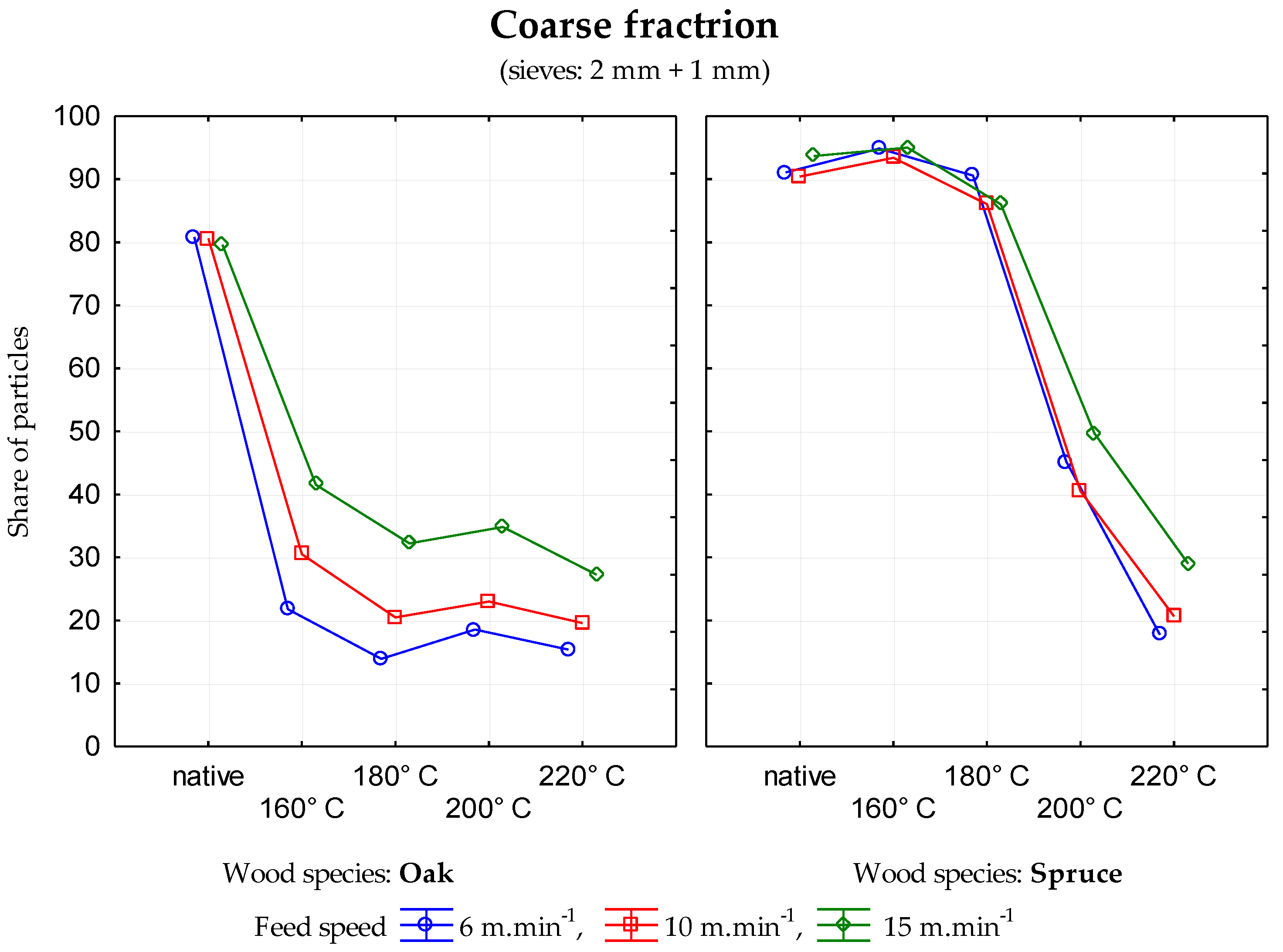
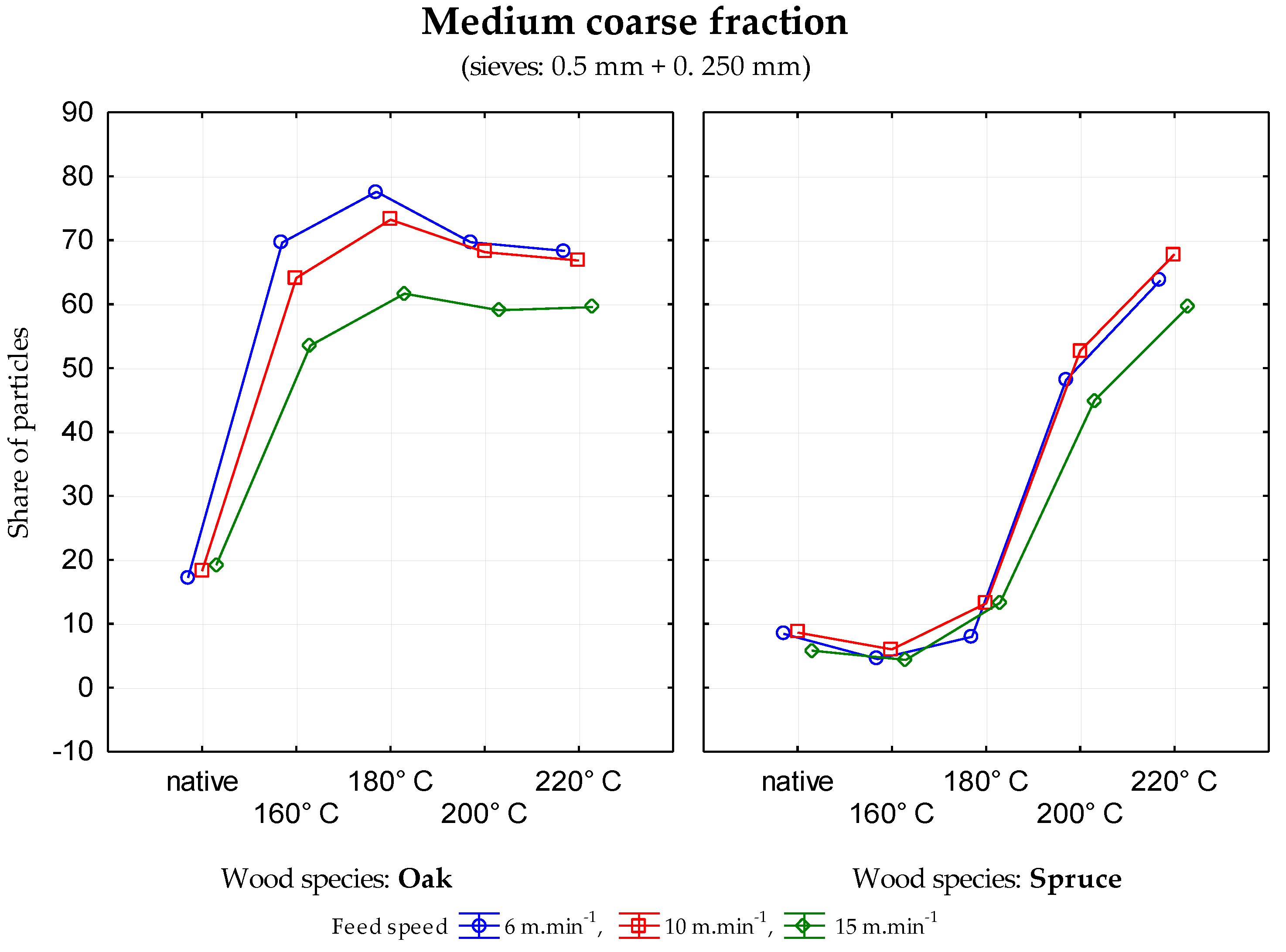
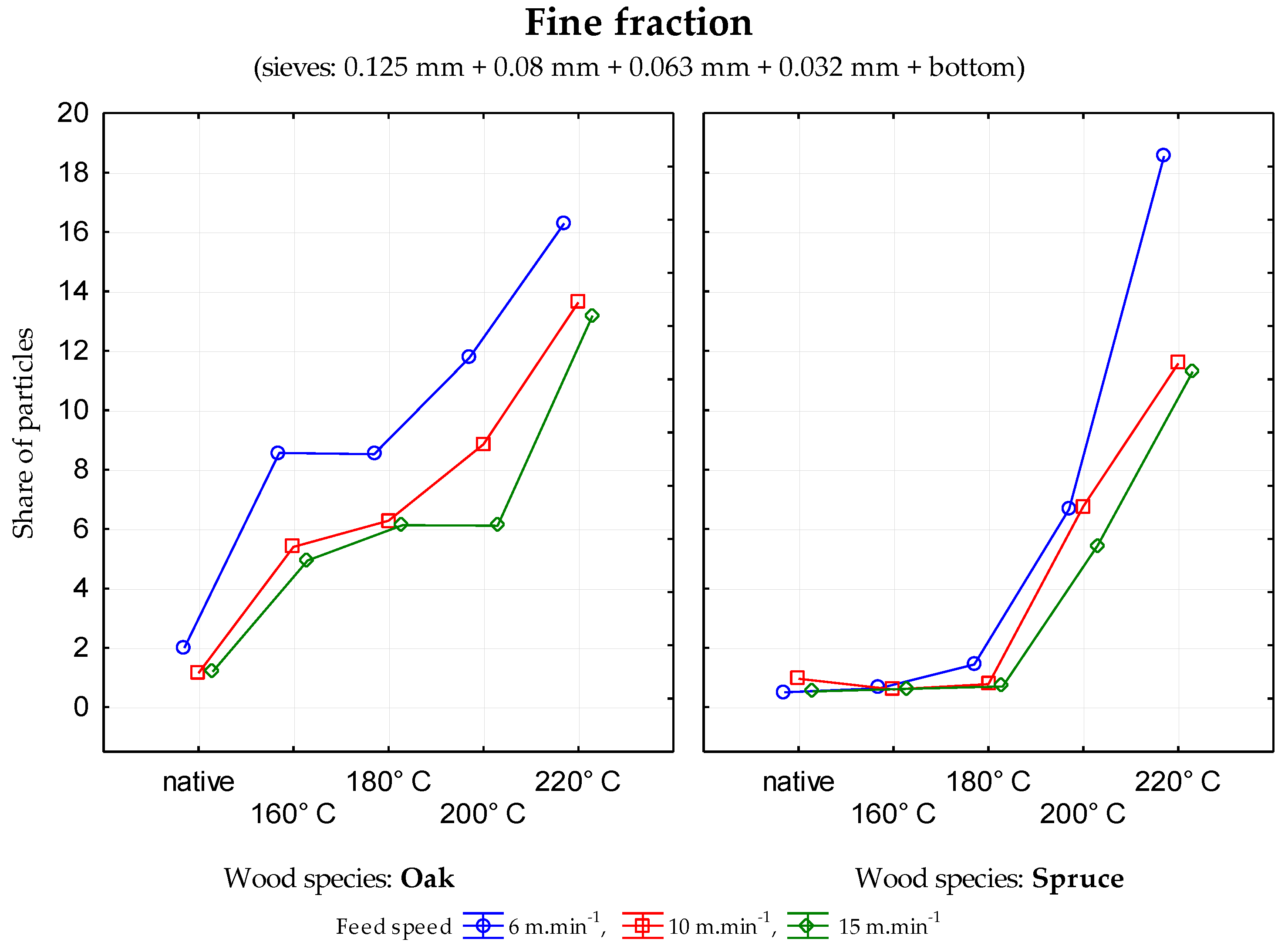
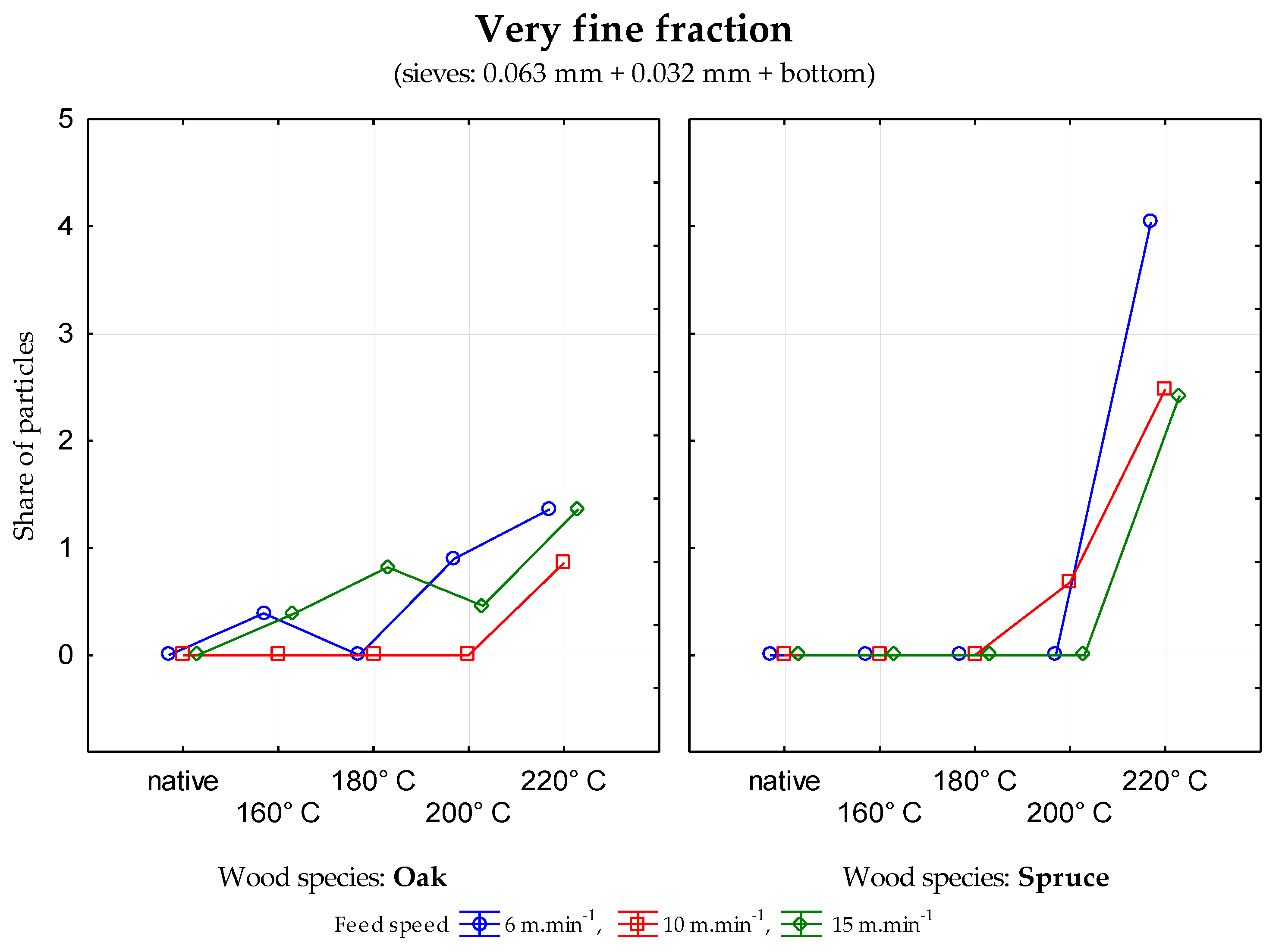
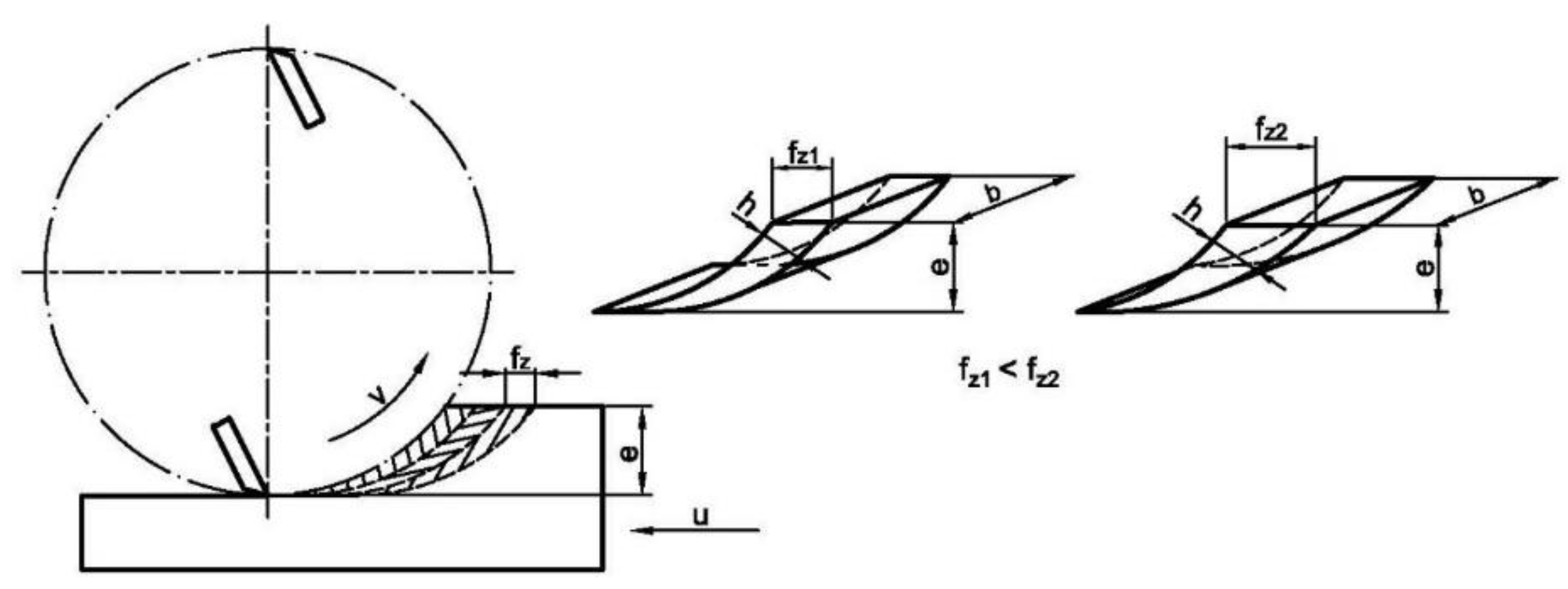
| Sieve | Oak | Spruce | ||||||||
|---|---|---|---|---|---|---|---|---|---|---|
| Native | 160 °C | 180 °C | 200 °C | 220 °C | Native | 160 °C | 180 °C | 200 °C | 220 °C | |
| 2 mm | 59.2 | 1.17 | 0.9 | 1.36 | 1.81 | 72.77 | 83.97 | 76.81 | 28.15 | 3.23 |
| 1 mm | 21.6 | 20.62 | 13 | 17.19 | 13.57 | 18.32 | 10.9 | 13.77 | 17.04 | 14.52 |
| 0.5 mm | 11.8 | 44.75 | 44.84 | 39.82 | 33.94 | 6.93 | 3.85 | 6.52 | 27.41 | 34.68 |
| 0.25 mm | 5.4 | 24.9 | 32.74 | 29.86 | 34.39 | 1.49 | 0.64 | 1.45 | 20.74 | 29.03 |
| 0.125 mm | 1.6 | 6.61 | 7.62 | 9.05 | 11.99 | 0.5 | 0.64 | 0.72 | 5.19 | 10.48 |
| 0.08 mm | 0.4 | 1.56 | 0.9 | 1.81 | 2.94 | 0 | 0 | 0.72 | 1.48 | 4.03 |
| 0.063 mm | 0 | 0.39 | 0 | 0.45 | 0.68 | 0 | 0 | 0 | 0 | 3.23 |
| 0.032 mm | 0 | 0 | 0 | 0.45 | 0.68 | 0 | 0 | 0 | 0 | 0.81 |
| Bottom | 0 | 0 | 0 | 0 | 0 | 0 | 0 | 0 | 0 | 0 |
| Sieve | Oak | Spruce | ||||||||
|---|---|---|---|---|---|---|---|---|---|---|
| Native | 160 °C | 180 °C | 200 °C | 220 °C | Native | 160 °C | 180 °C | 200 °C | 220 °C | |
| 2 mm | 53.35 | 3.09 | 1.67 | 2.65 | 3.4 | 67.94 | 73.65 | 58.91 | 15.54 | 1.65 |
| 1 mm | 27.25 | 27.41 | 18.83 | 20.35 | 16.17 | 22.49 | 19.76 | 27.13 | 25 | 19.01 |
| 0.5 mm | 13.16 | 43.24 | 48.12 | 42.48 | 35.32 | 7.18 | 4.79 | 10.85 | 34.46 | 43.8 |
| 0.25 mm | 5.08 | 20.85 | 25.1 | 25.66 | 31.49 | 1.44 | 1.2 | 2.33 | 18.24 | 23.97 |
| 0.125 mm | 0.92 | 4.63 | 5.44 | 7.08 | 10.64 | 0.96 | 0.6 | 0.78 | 4.73 | 6.61 |
| 0.08 mm | 0.23 | 0.77 | 0.84 | 1.77 | 2.13 | 0 | 0 | 0 | 1.35 | 2.48 |
| 0.063 mm | 0 | 0 | 0 | 0 | 0.43 | 0 | 0 | 0 | 0.68 | 1.65 |
| 0.032 mm | 0 | 0 | 0 | 0 | 0.43 | 0 | 0 | 0 | 0 | 0.83 |
| Bottom | 0 | 0 | 0 | 0 | 0 | 0 | 0 | 0 | 0 | 0 |
| Sieve | Oak | Spruce | ||||||||
|---|---|---|---|---|---|---|---|---|---|---|
| Native | 160 °C | 180 °C | 200 °C | 220 °C | Native | 160 °C | 180 °C | 200 °C | 220 °C | |
| 2 mm | 46 | 7.97 | 6.12 | 7.92 | 6.36 | 73.16 | 76.4 | 51.05 | 17.01 | 4.03 |
| 1 mm | 33.6 | 33.56 | 26.12 | 26.92 | 20.91 | 20.53 | 18.63 | 34.97 | 32.65 | 25 |
| 0.5 mm | 14.4 | 36.45 | 40.82 | 38.69 | 32.27 | 4.21 | 3.11 | 11.19 | 29.93 | 35.48 |
| 0.25 mm | 4.8 | 17.08 | 20.82 | 20.36 | 27.27 | 1.58 | 1.24 | 2.1 | 14.97 | 24.19 |
| 0.125 mm | 0.8 | 3.8 | 4.49 | 4.75 | 9.55 | 0.53 | 0.62 | 0.7 | 4.08 | 6.45 |
| 0.08 mm | 0.4 | 0.76 | 0.82 | 0.9 | 2.27 | 0 | 0 | 0 | 1.36 | 2.42 |
| 0.063 mm | 0 | 0.38 | 0.41 | 0.23 | 0.91 | 0 | 0 | 0 | 0 | 1.61 |
| 0.032 mm | 0 | 0 | 0.41 | 0.23 | 0.45 | 0 | 0 | 0 | 0 | 0.81 |
| Bottom | 0 | 0 | 0 | 0 | 0 | 0 | 0 | 0 | 0 | 0 |
| Coarse Fraction | |||||
|---|---|---|---|---|---|
| Factor | SS | Degrees of Freedom | MS | F-Value | p-Value |
| Feed rate | 526.5 | 2 | 263.3 | 0.8141 | 0.444993 |
| Tree species | 11,708.9 | 1 | 11,708.9 | 36.2064 | 0.000000 |
| Thermal modification | 22,382.7 | 4 | 5595.7 | 17.3030 | 0.000000 |
| Feed rate × Tree species | 200.3 | 2 | 100.1 | 0.3096 | 0.734184 |
| Feed rate × Thermal modification | 139.4 | 8 | 17.4 | 0.0539 | 0.999919 |
| Tree species × Thermal modification | 8041.3 | 4 | 2010.3 | 6.2164 | 0.000118 |
| Feed rate × Tree species × Thermal modification | 206.6 | 8 | 25.8 | 0.0798 | 0.999641 |
| Error | 48,509.1 | 150 | 323.4 | ||
| Medium Coarse Fraction | |||||
|---|---|---|---|---|---|
| Factor | SS | Degrees of Freedom | MS | F-Value | p-Value |
| Feed rate | 314.67 | 2 | 157.34 | 3.281 | 0.040291 |
| Tree species | 9544.08 | 1 | 9544.08 | 199.049 | 0.000000 |
| Thermal modification | 14,773.55 | 4 | 3693.39 | 77.028 | 0.000000 |
| Feed rate × Tree species | 152.72 | 2 | 76.36 | 1.593 | 0.206836 |
| Feed rate × Thermal modification | 78.95 | 8 | 9.87 | 0.206 | 0.989510 |
| Tree species × Thermal modification | 6720.21 | 4 | 1680.05 | 35.039 | 0.000000 |
| Feed rate × Tree species × Thermal modification | 159.56 | 8 | 19.95 | 0.416 | 0.910019 |
| Error | 7192.26 | 150 | 47.95 | ||
| Fine fraction | |||||
|---|---|---|---|---|---|
| Factor | SS | Degrees of Freedom | MS | F-Value | p-Value |
| Feed rate | 20.155 | 2 | 10.0775 | 2.1036 | 0.123295 |
| Tree species | 44.086 | 1 | 44.0861 | 9.2028 | 0.002566 |
| Thermal modification | 370.456 | 4 | 92.6141 | 19.3328 | 0.000000 |
| Feed rate × Tree species | 1.301 | 2 | 0.6507 | 0.1358 | 0.873021 |
| Feed rate × Thermal modification | 11.405 | 8 | 1.4256 | 0.2976 | 0.966621 |
| Tree species × Thermal modification | 24.391 | 4 | 6.0977 | 1.2729 | 0.279897 |
| Feed rate × Tree species × Thermal modification | 8.424 | 8 | 1.0529 | 0.2198 | 0.987335 |
| Error | 2012.016 | 420 | 4.7905 | ||
© 2020 by the authors. Licensee MDPI, Basel, Switzerland. This article is an open access article distributed under the terms and conditions of the Creative Commons Attribution (CC BY) license (http://creativecommons.org/licenses/by/4.0/).
Share and Cite
Očkajová, A.; Kučerka, M.; Kminiak, R.; Krišťák, Ľ.; Igaz, R.; Réh, R. Occupational Exposure to Dust Produced when Milling Thermally Modified Wood. Int. J. Environ. Res. Public Health 2020, 17, 1478. https://doi.org/10.3390/ijerph17051478
Očkajová A, Kučerka M, Kminiak R, Krišťák Ľ, Igaz R, Réh R. Occupational Exposure to Dust Produced when Milling Thermally Modified Wood. International Journal of Environmental Research and Public Health. 2020; 17(5):1478. https://doi.org/10.3390/ijerph17051478
Chicago/Turabian StyleOčkajová, Alena, Martin Kučerka, Richard Kminiak, Ľuboš Krišťák, Rastislav Igaz, and Roman Réh. 2020. "Occupational Exposure to Dust Produced when Milling Thermally Modified Wood" International Journal of Environmental Research and Public Health 17, no. 5: 1478. https://doi.org/10.3390/ijerph17051478
APA StyleOčkajová, A., Kučerka, M., Kminiak, R., Krišťák, Ľ., Igaz, R., & Réh, R. (2020). Occupational Exposure to Dust Produced when Milling Thermally Modified Wood. International Journal of Environmental Research and Public Health, 17(5), 1478. https://doi.org/10.3390/ijerph17051478








